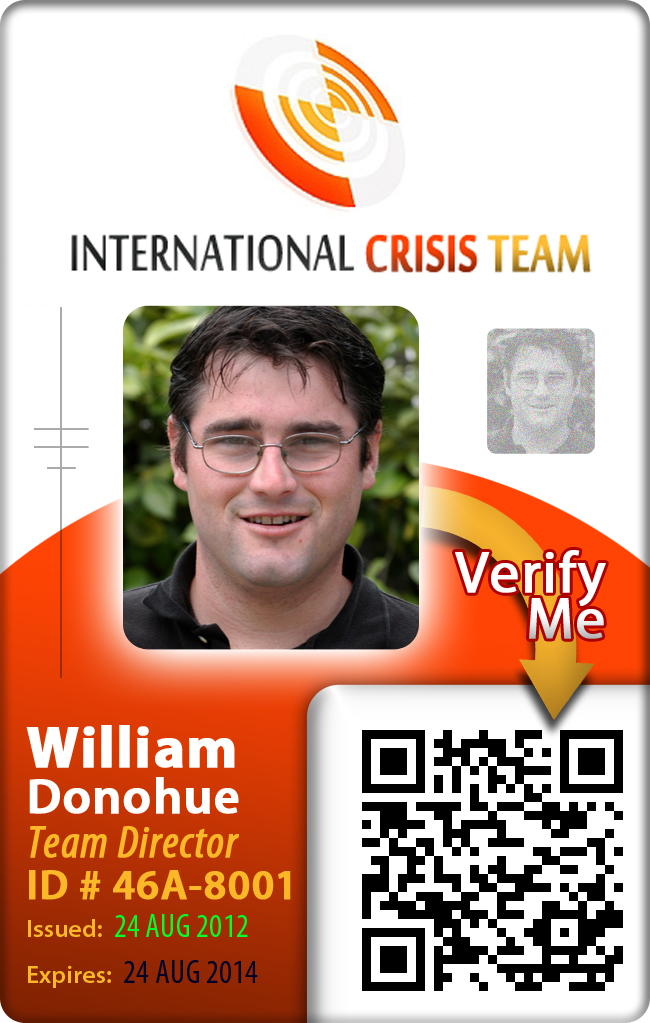
|
| New options in ID badging, including adding QR codes, can reduce the costs of adding layers of new information to cards, all while making the data accessible via smartphone. Image courtesy of InstantCard. |
Security officers often deal with photo ID card issuance as an afterthought, but companies should take advantage of the fact that these cards are the most visible daily reminder of security policy. When used strategically, ID cards can greatly facilitate deployment of a consistent companywide security policy.
Photo ID cards are evolving from their most basic level (a printed piece of plastic) toward advanced features, which may include barcodes, magstripes, proximity cards, smartcard technology and the newest development, Quick Response (QR) codes.
Typical company ID card programs, while not hugely expensive, are hugely inefficient. Most large organizations issue a multitude of different types of ID cards, at different locations, in different divisions, for different requirements. But every ID card is designed to positively identify the bearer and describe in some way his or her rights. Faced with the disparity of systems governing the issuance of ID cards, the CSO ought to have a plan for converging toward a common, secure, controlled card-issuance process.
This is particularly difficult in a multi-site organization, and especially where each site is relatively small. Because of the difficulty and apparent cost of rolling out a companywide program, many CSOs have simply put off implementing systematic programs and policies. The result is a relative degree of anarchy, with some sites well under control, and other sites open to significant security breaches.
As the CSO thinks through his options, he or she typically sees two equally unattractive alternatives: either set up an expensive headquarters operation to produce badges for everyone in the company, or delegate responsibility to regional and/or field offices. The first alternative ensures control but involves significant operational and logistics costs. The second alternative involves the costs of multiple underutilized assets and a loss of control and consistency.
Since traditional physical security has been local, many field organizations are left to their own devices to produce cards, implement technologies and apply policy. The result is often an inconsistent mish-mosh.
Any inconsistent security policy automatically opens up greater potential for security breaches. Consistency involves human factors, IT systems, operational procedures and managerial control. Once the photo ID card policy has been set, this requires clear communications and adequate means to avoid making adherence to policy overly onerous. Policies must be implemented uniformly at both headquarters and in the field.
Consistency can be achieved through centralized ID card production, where all cards are produced at HQ, based on information supplied from authorized managers in field offices. But the overhead and logistics costs can be very high, and service to the field offices is often poor. Few multi-site organizations have been able to effectively implement such a program in a way which is satisfactory to field managers.
There is another choice. Outsourcing is a highly cost-effective but often overlooked alternative. ID card production is well suited to outsourcing because it’s not a core function, and specialized service providers offer significant economies of scale. Outsourcing can change a capital cost into an operating expense, turning fixed overhead expenses into costs that vary with demand. Specialized ID card providers can often ensure same-day service to remote locations, at a far lower cost, than either centralized or decentralized in-house production.
Outsourcing ID card production can ensure consistency across all offices. By choosing a single external supplier, the CSO can ensure that all ID cards conform to enterprise norms and can track when/where card programs are on track, and where they need remediation.
Technology
Many CSOs want IDs to go beyond simple “flash” cards and look to smartcards as a solution. While combining the smartcard with the photo ID card offers powerful, advanced security features, the costs are high because of the complex infrastructure required.
Adding QR codes to ID cards can often provide similar benefits — such as being able to instantly see the cardholder’s authorizations and credentials — at a fraction of the cost. A QR code is the black-and-white square often seen in magazine advertisements. QR codes, a non-proprietary scanning technology, can be printed on photo ID cards at little added cost. The codes can be read in the field with any smartphone: iPhone, Android or Blackberry.
There are more options in photo ID cards than ever. With a little research, you can find the right choice for your organization.



